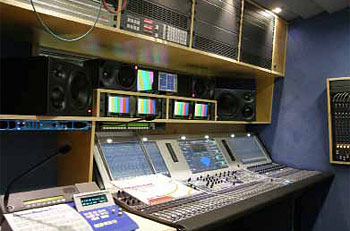STB Ukraine's 'Got Talent'
Ukraine's Got Talent, Tancuyut Vse (the Ukrainian version of So You Think You Can Dance) and The X Factor (Ukrainian version) are just three of the popular TV shows produced by and aired on STB Ukraine. Launched in June, 1997, STB Ukraine is one of the country's most popular networks. Its broadcasts cover 85 percent of Ukraine's territory.
To produce these and other live shows, STB recently purchased an 11-camera OB van. It was built by TVC (Televizijos ir rysio sistemos, UAB). TVC is headquartered in Lithuania, and has offices in Ukraine, Belarus, Georgia, Kazakhstan and Latvia.

Although STB broadcasts in SD, "our OB truck can produce in both HD and SD," says Ivan Zabaluyev, STB's Chief Sound Supervisor. "It works very well in the field. We use it to produce many of our own shows."
Nuts and Bolts
In honour of its ability to support up to 18 cameras, STB's OB van has been christened "HDTV OB Van 18." It is a 12m long, 3.95m tall freight-style box built on the chassis of a Mercedes ACTROS 2532L truck, with expandable sides that broaden the production box's width from 2.5m to 3.5m.
HDTV OB Van 18's walls have thick insulation to deal with the Ukraine's cold winters; plus air conditioning to cope with the summer heat. Because it is meant to be an all-in-one production unit, the truck has special compartments for carrying cable drums and cameras.
Despite its 18-camera capacity, STB operates this truck using 11 cameras. All of these are Sony HSC-300PK camera heads. Equipped with three 2.2 megapixel 2/3-inch CCDs, the Sony HSC-300PK camera can connect via long-distance digital triax for cable runs up to 1800 metres. These cameras can shoot in SD, 1080i and 720p formats.
Ten of the Sonys are used as wired units. The truck also has a Link L1500 SD/HD wireless camera transmitter, which is used with a Sony HSC-300PK. STB uses a wide range of Canon lenses on these cameras. Their video is recorded on GrassValley K2 Summit video servers.
HDTV OB Van 18's video mixing is handled using a Snell Kahuna 40 input/32 output, 2.5 ME switcher. The guts of this SD/HD mixer are housed in a single compact 6RU frame. Video is displayed on a wall made up of TVLogic LCDs, with the main screen fed by an Image Video HD Quad Split processor. Routing is achieved using a Snell 128x128 video matrix.
Production audio is managed using a Lawo mc256 HD mixing console. This mixer uses the Lawo HD core, which offers up to 512 DSP channels, 144 summing buses and a routing capacity of up to 8192 crosspoints.
STB uses the Lawo mixer with four external stage boxes. "Stage box 1 has 64 inputs and 32 outputs," says Ivan Zabaluyev. "Stage boxes 2 and 3 each have 32 inputs and 16 outputs. Stage box 4 has 16 ins and 16 outs."
For intercom communications, "We use two Riedel systems; a Riedel Artist with a 128 mainframe and a Riedel Acrobat with CC8 main unit," he tells TV Technology Europe. Specifically, the truck is equipped with eight Riedel Artist 2000 series and six Artist 5000 series desktop control panels.
Meanwhile, the Riedel Acrobat unit provides full-duplex wireless VoIP-over-DECT communications. Each of HDTV OB Van 18's ten Acrobat Wireless Beltpacks continuously monitor and automatically select the best connection to the Acrobat Cell Controller – without interfering with IEMs or wireless microphones.
"All of the systems interconnected very well," says Zabaluyev. "We also use MADI Riedel units to provide the talent with in-ear connections to our intercom system."
STB's HDTV OB Van 18 began its operational life in October, 2010, when it began shooting the channel's version of The X-Factor. The unit is currently filming episodes of the Uri Geller mentalist contest show Phenomenon, and will soon work on the channel's Fool Us show as well.
"We will also keep using HDTV OB Van 18 to shoot Ukraine's Got Talent, Tancuyut Vse, and The X Factor, " says Ivan Zabaluyev. "It has proven itself to be a reliable production platform for our live shows. The only improvement we are seeking is to add more long-distance lenses to our equipment, so that we can do better close-ups on large-scale productions."
The professional video industry's #1 source for news, trends and product and tech information. Sign up below.
James Careless is an award-winning journalist who has written for TV Technology since the 1990s. He has covered HDTV from the days of the six competing HDTV formats that led to the 1993 Grand Alliance, and onwards through ATSC 3.0 and OTT. He also writes for Radio World, along with other publications in aerospace, defense, public safety, streaming media, plus the amusement park industry for something different.

